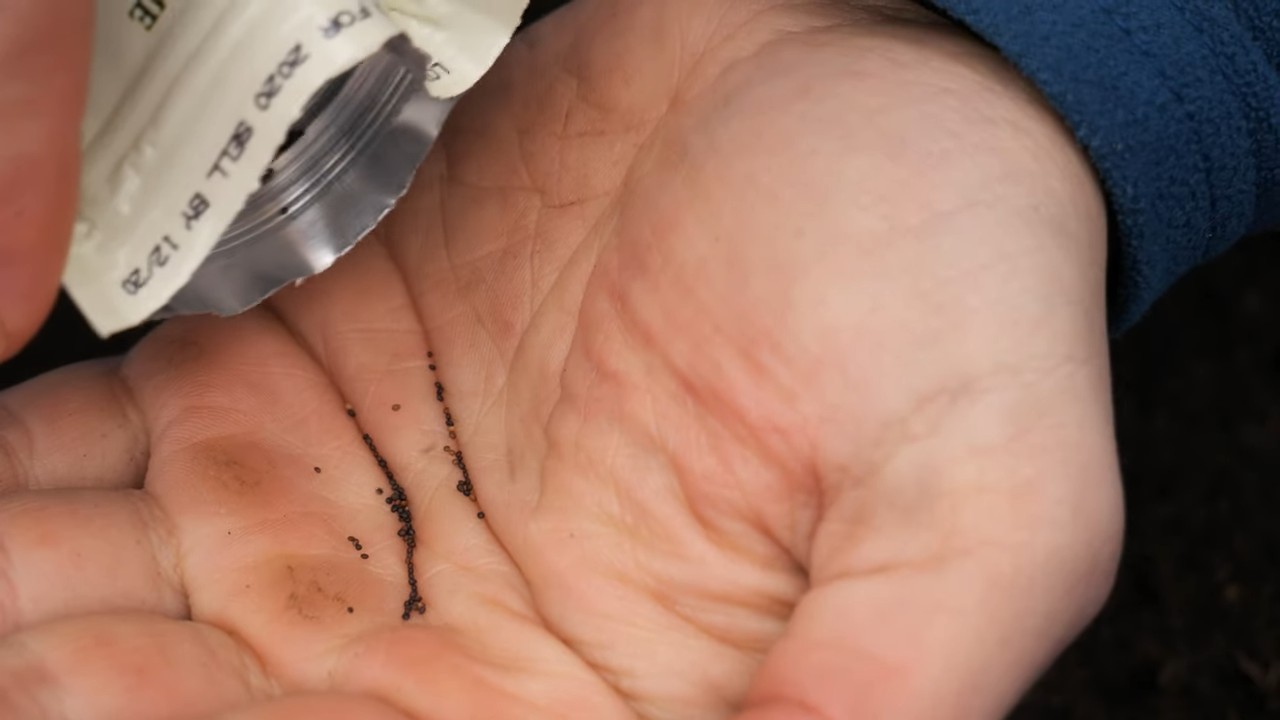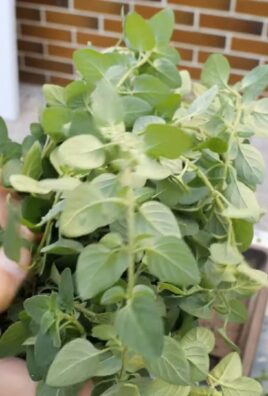Growing Thyme at Home is easier than you might think, and I’m so excited to share some simple DIY tricks that will have you harvesting fresh, fragrant thyme in no time! Forget those expensive, pre-packaged herbs from the grocery store – imagine stepping right outside your door to snip the perfect sprig for your culinary creations.
Thyme, with its rich history dating back to ancient Egypt where it was used for embalming, and its significance in ancient Greece as a symbol of courage, has been cherished for centuries. It’s not just a flavorful herb; it’s a piece of history you can cultivate in your own backyard or even on your windowsill!
But why should you bother with these DIY tricks for growing thyme at home? Well, for starters, it’s incredibly rewarding to nurture something from seed to harvest. Plus, fresh thyme has a far superior flavor compared to dried. More importantly, knowing exactly where your herbs come from gives you peace of mind, free from worries about pesticides or unknown growing practices. I’ve found that incorporating these simple hacks not only saves money but also adds a touch of green therapy to my daily routine. So, let’s dive into some easy and effective ways to cultivate your own thriving thyme patch!

Growing Thyme at Home: Your Comprehensive DIY Guide
Hello garden friends! I love having fresh herbs right on my doorstep. And thyme is at the top of my list! It’s not only super versatile in the kitchen but also low-maintenance and has a wonderful fragrance. In this article, I’ll show you how to easily grow thyme yourself, whether in the garden, on the balcony, or even on a windowsill. Let’s get started!
What You Need: The Right Equipment and Materials
Before we begin, make sure you have everything you need. Here is a list of the things you’ll need:
- Thyme seeds or young plants: You can grow thyme from seed or buy young plants from a nursery. I personally find young plants easier, especially for beginners.
- Suitable soil: Thyme prefers well-draining, sandy soil. A mixture of garden soil, sand, and compost is ideal.
- Pots or planters: Choose pots with drainage holes to prevent waterlogging. The size depends on how much thyme you want to grow.
- Garden shears or scissors: For pruning the thyme.
- Watering can or spray bottle: For watering the plants.
- Optional: Fertilizer for herbs (organic or mineral).
- Optional: Mulch (e.g., gravel or small stones) for weed control and moisture retention.
Growing Thyme: A Step-by-Step Guide
Here is a detailed guide on how to successfully grow thyme. I have divided the process into different phases to make it clearer.
Phase 1: Preparation
- Choose a location: Thyme loves the sun! Choose a sunny spot with at least 6 hours of direct sunlight per day. If you are growing thyme indoors, place it on a sunny windowsill.
- Prepare the soil: If you are growing thyme in pots, fill the pots with the prepared soil. Make sure the soil is loose and well-draining. If you are growing thyme in the garden, loosen the soil and mix in sand and compost to improve drainage.
- Choose your growing method: Decide whether you want to grow thyme from seeds or use young plants. Both methods have their pros and cons.
Phase 2: Sowing or Planting
1. Sowing from Seed:
- Fill small starter pots or a seed tray with seed-starting mix.
- Lightly moisten the soil.
- Sprinkle the thyme seeds thinly on the soil. Thyme is a light germinator, so do not cover the seeds with soil.
- Gently press the seeds down.
- Cover the starter pots or seed tray with a transparent film or a lid to increase humidity.
- Place the containers in a warm, bright place (but not in direct sun).
- Keep the soil moist, but not wet.
- Once the seedlings are large enough (about 5-7 cm / 2-3 inches), you can transplant them into larger pots or outdoors.
2. Planting Young Plants:
- Dig a hole that is slightly larger than the root ball of the young plant.
- Carefully remove the young plant from its pot and gently loosen the root ball.
- Place the young plant in the hole and fill it with soil.
- Gently press the soil down.
- Water the young plant thoroughly.
- Plant the thyme plants about 20-30 cm (8-12 inches) apart to give them enough space to grow.
Phase 3: Care
- Watering: Thyme is relatively drought-resistant, so you shouldn’t water it too often. Only water when the soil is dry. Avoid waterlogging, as this can lead to root rot. It’s best to water in the morning so the leaves can dry during the day.
- Fertilizing: Thyme does not need much fertilizer. If you want to fertilize, use an organic herb fertilizer or a diluted liquid fertilizer. Only fertilize during the growing season (spring and summer).
- Pruning: Regular pruning promotes growth and prevents the thyme from becoming woody. Cut the shoots back regularly, especially after flowering. Also, remove dead or diseased shoots.
- Weed Control: Regularly remove weeds that grow around the thyme. Mulch can help reduce weed growth.
- Overwintering: Thyme is hardy, but in cold regions, it can be beneficial to cover it with brushwood or fleece to protect it from frost. If you are growing thyme in pots, you can move the pots to a sheltered location, such as a shed or a garage.
Common Problems and Solutions
Problems can also occur when growing thyme. Here are some common problems and how you can solve them:
- Yellow leaves: Yellow leaves can be a sign of overwatering or a nutrient deficiency. Check your watering and fertilize if necessary.
- Root rot: Root rot is caused by waterlogging. Make sure the soil is well-draining and do not water too often.
- Pests: Thyme is relatively resistant to pests, but occasionally aphids or spider mites may appear. Combat the pests with a biological insecticide or a soap solution.
- Woodiness: Woodiness occurs when the thyme is not pruned regularly. Cut back the woody shoots to encourage the growth of new ones.
Harvesting and Using Thyme
You can harvest thyme all year round. It is best to harvest it in the morning when the essential oils are most concentrated. Cut the shoots with scissors or garden shears. You can use fresh thyme immediately or dry it to make it last longer.
Drying Thyme:
- Cut the thyme shoots.
- Tie the shoots into small bundles.
- Hang the bundles in a dry, airy place, such as a shed or the attic.
- Let the bundles dry until the leaves are brittle.
- Strip the dried leaves from the stems and store them in an airtight container.
Using Thyme:
Thyme is a versatile herb that can be used in many dishes. It pairs well with meat, fish, vegetables, soups, and sauces. You can also use it for tea or to flavor oil and vinegar. I love to add fresh thyme to my pasta sauces or mix it with olive oil and garlic to make a delicious herb oil.
Additional Tips and Tricks
Propagating Thyme: You can propagate thyme from cuttings. In the spring or summer, cut a shoot about 10 cm (4 inches) long and remove the lower leaves. Stick the cutting in moist soil and keep it moist until it takes root.

Conclusion
So, there you have it! Growing thyme at home isn’t just a whimsical dream for those with sprawling gardens; it’s an achievable reality for anyone, anywhere, with a little sunshine and a dash of know-how. We’ve walked through the simple steps, debunked common myths, and armed you with the knowledge to cultivate your own fragrant patch of this culinary and medicinal marvel.
Why is this DIY trick a must-try? Because fresh thyme, bursting with flavor and aroma, elevates your cooking to a whole new level. Imagine snipping sprigs of your own homegrown thyme to season roasted chicken, infuse olive oil, or add a herbaceous note to your favorite soups and stews. The difference between store-bought dried thyme and freshly harvested thyme is truly remarkable – a vibrant, aromatic explosion that will tantalize your taste buds. Beyond the culinary benefits, growing thyme is also incredibly rewarding. It’s a connection to nature, a therapeutic activity, and a beautiful addition to your home, whether it graces your windowsill, balcony, or garden.
But the beauty of growing thyme at home lies in its versatility. Feel free to experiment with different varieties! Lemon thyme adds a citrusy zing to your dishes, while creeping thyme makes a stunning ground cover. Consider planting thyme in decorative pots to add a touch of rustic charm to your kitchen or patio. You can even dry your excess thyme to create your own herb blends or infuse oils for gifts. The possibilities are endless!
Don’t be intimidated by the prospect of gardening. Growing thyme is surprisingly easy, even for beginners. With a little attention to detail and the tips we’ve shared, you’ll be harvesting your own fragrant thyme in no time.
We wholeheartedly encourage you to embark on this rewarding journey. Start small, be patient, and don’t be afraid to experiment. The satisfaction of using your own homegrown herbs in your cooking is truly unparalleled.
Now, it’s your turn! Grab a pot, some soil, and a thyme seedling (or seeds!), and get growing. We’re confident that you’ll be amazed at how easy and rewarding it is to cultivate your own thyme at home.
And most importantly, we want to hear about your experience! Share your tips, tricks, and triumphs in the comments below. Let’s create a community of thyme-loving gardeners and inspire others to discover the joy of growing their own herbs. What variety did you choose? What challenges did you face, and how did you overcome them? What are your favorite ways to use your homegrown thyme? Your insights will be invaluable to other aspiring gardeners. Let’s grow together!
Frequently Asked Questions (FAQ)
What is the best time of year to plant thyme?
The best time to plant thyme depends on your climate. In general, spring or early summer, after the last frost, is ideal. This allows the thyme plants to establish themselves before the colder months. If you live in a warmer climate, you can also plant thyme in the fall. However, avoid planting during the hottest part of summer, as the young plants may struggle to survive. When starting from seeds, it’s best to start them indoors 6-8 weeks before the last expected frost. This gives them a head start and increases their chances of success when transplanted outdoors.
How much sunlight does thyme need?
Thyme thrives in full sun, requiring at least 6-8 hours of direct sunlight per day. Insufficient sunlight can lead to leggy growth, reduced flavor, and increased susceptibility to diseases. If you’re growing thyme indoors, place it near a sunny window or use a grow light to supplement natural light. Rotate the pot regularly to ensure even exposure to sunlight. If you notice your thyme plants becoming stretched or pale, it’s a sign that they need more light.
What kind of soil is best for growing thyme?
Thyme prefers well-draining soil that is slightly alkaline. Heavy clay soil can lead to root rot, so it’s essential to amend the soil with organic matter, such as compost or peat moss, to improve drainage. A soil pH of 6.0 to 7.5 is ideal. You can test your soil pH using a soil testing kit available at most garden centers. If your soil is too acidic, you can add lime to raise the pH. When growing thyme in containers, use a potting mix specifically formulated for herbs or a well-draining general-purpose potting mix.
How often should I water thyme?
Thyme is drought-tolerant and prefers to be watered sparingly. Overwatering can lead to root rot, so it’s essential to allow the soil to dry out between waterings. Water deeply when the soil is dry to the touch, but avoid getting the foliage wet. During hot, dry weather, you may need to water more frequently. However, always check the soil moisture before watering to avoid overwatering. In the winter, reduce watering significantly, as the plants will be dormant.
Does thyme need fertilizer?
Thyme is not a heavy feeder and does not require frequent fertilization. In fact, over-fertilizing can lead to leggy growth and reduced flavor. If your soil is poor, you can amend it with compost or a slow-release organic fertilizer at planting time. Avoid using high-nitrogen fertilizers, as they can promote excessive foliage growth at the expense of flavor. You can also apply a diluted liquid fertilizer once or twice during the growing season if needed.
How do I harvest thyme?
You can harvest thyme throughout the growing season, as needed. Simply snip off sprigs of thyme using scissors or pruning shears. Avoid cutting back more than one-third of the plant at a time, as this can weaken it. The best time to harvest thyme is in the morning, after the dew has dried, as the essential oils are most concentrated at this time. You can use fresh thyme immediately or dry it for later use. To dry thyme, hang sprigs upside down in a cool, dry, well-ventilated place until they are brittle. Then, crumble the dried leaves and store them in an airtight container.
How do I propagate thyme?
Thyme can be propagated easily from stem cuttings or by division. To propagate from stem cuttings, take 4-6 inch cuttings from healthy stems in the spring or summer. Remove the lower leaves and dip the cut end in rooting hormone. Plant the cuttings in a well-draining potting mix and keep them moist until they root. To propagate by division, carefully dig up a mature thyme plant in the spring or fall and divide the root ball into smaller sections. Replant the divisions in separate pots or in the garden.
What are some common problems when growing thyme?
Some common problems when growing thyme include root rot, fungal diseases, and pests such as aphids and spider mites. Root rot is caused by overwatering and poorly draining soil. To prevent root rot, ensure that your thyme plants are planted in well-draining soil and avoid overwatering. Fungal diseases can be caused by excessive humidity and poor air circulation. To prevent fungal diseases, provide good air circulation around your thyme plants and avoid getting the foliage wet when watering. Aphids and spider mites can be controlled with insecticidal soap or neem oil.
Can I grow thyme indoors?
Yes, you can absolutely grow thyme indoors! Choose a sunny location, such as a windowsill that receives at least 6 hours of direct sunlight per day. Use a well-draining potting mix and a pot with drainage holes. Water sparingly, allowing the soil to dry out between waterings. Rotate the pot regularly to ensure even exposure to sunlight. You may also need to supplement natural light with a grow light, especially during the winter months.
What are some different varieties of thyme I can grow?
There are many different varieties of thyme to choose from, each with its own unique flavor and aroma. Some popular varieties include:
* **Common Thyme (Thymus vulgaris):** The most common variety, with a classic thyme flavor.
* **Lemon Thyme (Thymus citriodorus):** Has a distinct lemon scent and flavor.
* **Creeping Thyme (Thymus serpyllum):** A low-growing variety that makes a great ground cover.
* **Woolly Thyme (Thymus pseudolanuginosus):** Has soft, fuzzy leaves and a mild flavor.
* **Silver Thyme (Thymus argenteus):** Has variegated silver and green leaves.
Experiment with different varieties to find your favorites!





Leave a Comment